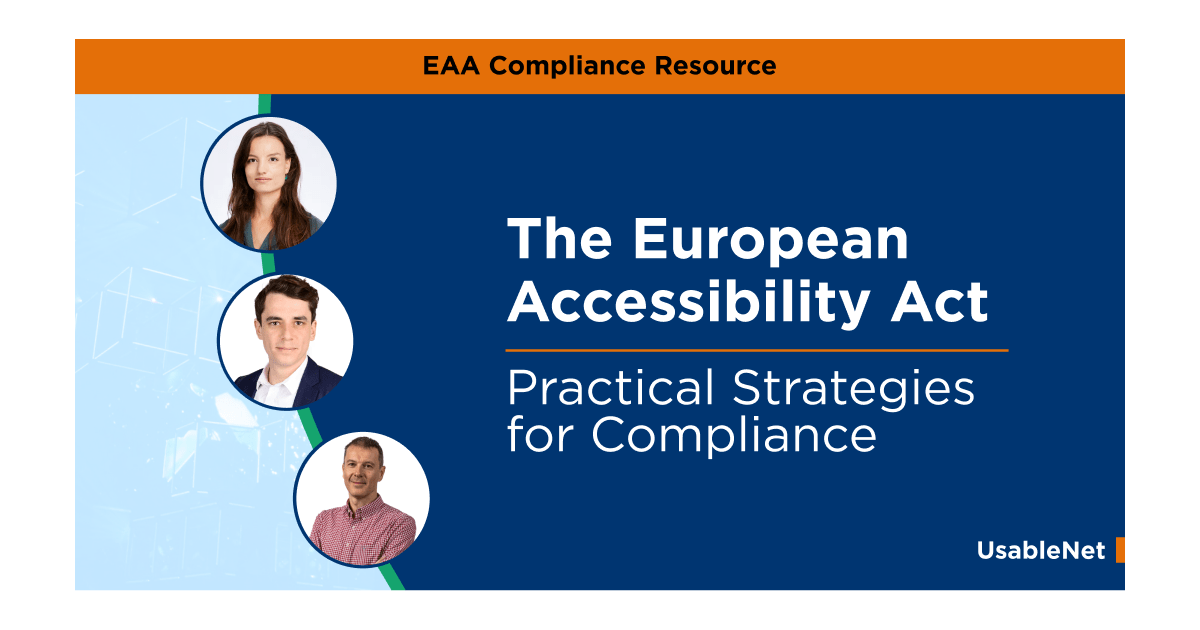The European Accessibility Act (EAA) sets clear expectations for making digital products and services accessible to people with disabilities across Europe. Follow along as we explore how organizations can understand the EAA’s scope, implement sustainable accessibility practices, create effective testing programs, and maintain compliance over time. We'll also cover strategies for websites, apps, and other digital workflows, offering actionable takeaways to ensure inclusivity and meet legal requirements.
The contents of this blog include excerpts from our webinar: The European Accessibility Act in Action: Practical Strategies for Compliance. A special thanks to FieldFisher’s Dr. Patrick Viktor Born and Merel van Aar for sharing their perspective on the EAA across digital products and services.
The materials in this blog are for education only and should not be used as legal advice
The European Accessibility Act: Scope and Purpose

The EAA's scope and purpose taken from our webinar The European Accessibility Act in Action: Practical Strategies for Compliance.
The EAA aims to create a more inclusive society by improving access to products and services for people with disabilities. It applies broadly to digital products and services, including websites and apps that facilitate consumer transactions. A “consumer contract” isn’t limited to direct online sales. It can include any interaction intended to eventually lead to a contract, such as booking an appointment at a local store.
Key takeaway: Treat your entire digital presence as in-scope, map all consumer interactions, and prioritize accessibility to reduce risk and improve inclusivity.
Lessons from French Accessibility Enforcement

Excerpts of the French EAA notices sent out taken from our webinar The European Accessibility Act in Action: Practical Strategies for Compliance.
Legal notices from two French associations for the visually impaired demonstrate the real-world consequences of inaccessible websites. In one case, supermarket customers were unable to select the free “click and collect” option due to accessibility barriers and were required to pay for delivery. Users also reported difficulties navigating sections, choosing options, and using low-contrast interfaces.
The associations emphasized that a non-accessible digital interface is as limiting for visually impaired users as a staircase would be for someone in a wheelchair. These notices indicate that non-compliance can result in legal action, and retailers and other digital service providers in the EU must prioritize accessibility.
Key takeaway: Accessibility is not optional. Companies must provide fully usable digital experiences or risk legal and reputational consequences.
How to Sustain Web Accessibility Efforts

Best practices for achieving accessibility, as outlined in The European Accessibility Act in Action: Practical Strategies for Compliance.
Achieving and maintaining accessibility demands embedding accessibility into processes, culture, and workflows.

Key EAA strategies taken from our webinar The European Accessibility Act in Action: Practical Strategies for Compliance.
Start by understanding the scope and responsibilities across design, content, and code. Identify internal and third-party contributors and clarify who is accountable for delivering accessible solutions. Conduct audits to assess current status and define remediation steps, involving internal teams or external experts as needed.

Embedding Accessibility into workflows taken from our webinar The European Accessibility Act in Action: Practical Strategies for Compliance.
Sustainable accessibility also requires continuous monitoring and documentation. Update accessibility statements, track changes, and build evidence for audits, training, and vendor assurances. Communication across the organization is essential; awareness and a shared culture make accessibility a priority rather than a one-off project.
Key takeaway: Embed accessibility into ongoing processes, assign responsibilities, and foster organizational culture to maintain compliance and inclusivity over time.
Understanding the EAA Technical Requirements

Understanding the EAA technical requirements, taken from our webinar The European Accessibility Act in Action: Practical Strategies for Compliance.
The EAA is supported by the EN technical guideline, which mirrors WCAG 2.1 AA, the worldwide standard for digital accessibility. For organizations already following WCAG, aligning with the EAA’s EN standard should feel familiar. An updated guideline now references AA compliance directly, making it the recommended focus for current and future efforts.
Beyond technical compliance, the EAA emphasizes process-oriented adherence. Organizations must document accessibility processes at every stage of a digital property’s lifecycle—design reviews, coding standards, QA checks, pre-launch verification, and post-launch monitoring. Demonstrating both technical and process compliance builds digital maturity and legal protection.
Key takeaway: Align with WCAG 2.1 AA standards and document accessibility processes across the entire lifecycle to demonstrate compliance under the EAA.
Accessibility Testing Across the Lifecycle

How to Create an Effective Testing Program taken from our webinar The European Accessibility Act in Action: Practical Strategies for Compliance.
Effective accessibility testing relies on both automation and manual evaluation. Automation supports development, quality assurance, and regression monitoring, but it cannot fully validate accessibility. The majority of WCAG or EN success criteria require manual expert review.
Testing should occur at every stage:
- Design: Involve accessibility-experienced design teams to embed accessibility from the start.
- Development: Equip developers with tools, skills, and code checks to produce accessible components.
- Content: Provide authors with guidelines and tools to ensure accessible content, extending to social media and other digital narratives.
- QA & Monitoring: Combine automated scans with expert reviews and user testing involving people with disabilities.

Accessibility testing across the lifecycle taken from our webinar The European Accessibility Act in Action: Practical Strategies for Compliance.
Key takeaway: Accessibility must be tested throughout the lifecycle using both automation and human evaluation to ensure meaningful results.
Ensuring EAA Compliant Handling

EAA Compliant Handling, taken from our webinar The European Accessibility Act in Action: Practical Strategies for Compliance.
Maintaining an accessible digital property also requires robust evidence and clear accountability. Build a library that documents audits, remediation efforts, monitoring activities, training, and assurances from third-party vendors. Assign clear responsibilities and establish prioritization rules for addressing accessibility issues.
Key takeaway: Document your efforts, assign responsibilities, and implement a prioritization process to manage accessibility effectively and maintain EAA compliance.
Partner with Experts for Accessibility Compliance Success
Meeting EAA compliance requires expertise, resources, and sustained commitment. Working with an experienced accessibility partner with knowledge of the EAA and accessibility standards like the WCAG and EN 301 549 requirements can help.
UsableNet provides comprehensive support for government entities and their vendors, including detailed compliance guidance, thorough auditing services, and end-to-end remediation support.
Whether you're just beginning your compliance journey or need assistance with specific remediation challenges, professional guidance can help ensure you meet deadlines while building sustainable accessibility programs.
Ready to start your EAA compliance planning? Contact UsableNet. Our Web Accessibility solutions are tailored to your needs. Whether you need a managed service to do the heavy lifting or an accessibility testing platform to perform your own accessibility remediation, our tools meet you where you are.
Explore our EAA Resource Hub to learn how we can help you meet your deadline.






